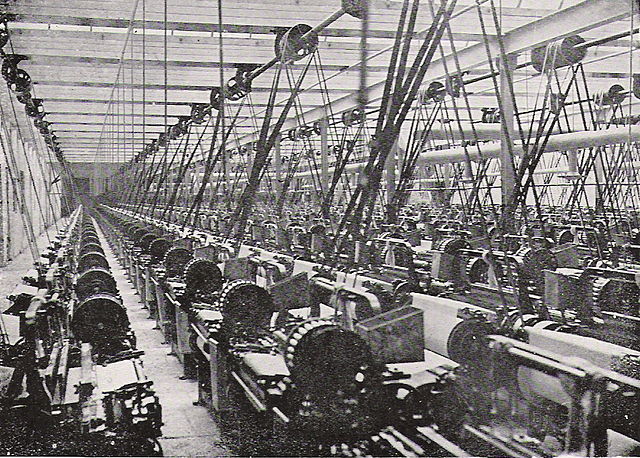The Industrial Revolution – From Steam to Steel
Chapter 11 - Unveiling the Age of Industry
The Salamanca (1812) and the Dawn of a New Era
Unveiling the Age of Industry in America and Britain
The Salamanca and the Rails of Change

Image from 1829 author unknown, Public domain, via Wikimedia Commons
In 1812, the Salamanca, the first commercially successful steam locomotive, chugged along the tracks of industrial history, marking the beginning of a transformative era in transportation. This iron horse was not just a feat of engineering but a symbol of the sweeping changes about to engulf economies and societies.
The "Salamanca" was the name given to the first railway locomotive to use twin-cylinder engines, and it was built in 1812 by Matthew Murray of Fenton, Murray and Wood, a company based in Leeds, England. This locomotive was used on the Middleton Railway, also in Leeds. The Salamanca is particularly noted for being one of the earliest steam locomotives to use two cylinders, a significant advancement at the time.
Matthew Murray was an influential engineer and inventor during the Industrial Revolution. His development of the Salamanca marked a significant step in the evolution of steam locomotive design. Murray's design included a rack and pinion system for propulsion, a novel solution to the problem of providing adequate traction for the locomotive on the cast iron rails of that era. This innovation, among others, contributed significantly to developing and expanding early railways.
The Industrial Revolution's Grand Stage IN BRITAIN
We witness an extraordinary transition from the gritty Gold Rush landscapes to the smoke-filled skies of the Industrial Revolution. Starting in the late 18th century and thundering through the 19th, this era was marked by a shift from agrarian handiwork to mechanised mass production. This revolution did not just modify production techniques; it reinvented the societal and economic fabric.

Image by Noble and Butlin, Public domain, via Wikimedia Commons
Powering Up Societies
The Steam Engine: Heartbeat of the Revolution

Image by Robert H. Thurston, Public domain, via Wikimedia Commons
James Watt's steam engine, pulsing with power and potential, drove the Industrial Revolution forward. These mechanical giants fueled factories, empowered steamships and railways, and became the cornerstone of industrialisation.

Image by Henry A. Papprill, CC0, via Wikimedia Commons
The wrought iron steamship Great Britain was built in 1843 in Bristol under the supervision of Brunel for the Great Western Steamship Company. Great Britain set the design standards for today's modern shipping and eminently demonstrated the industry and inventiveness of the Victorian era.
Weaving New Social Tapestries
In this era, factories emerged as the new workplaces, congregating workers under their roofs and restructuring both professional and personal lives. Cities swelled, driven by rural-to-urban migration, setting the blueprint for modern urbanisation.

Image by E.L. Hoskyn, Public domain, via Wikimedia Commons
The factory system introduced a new way of working and living. People worked long hours under challenging conditions, leading to social reform movements. The rise of the working class and the burgeoning middle class redefined societal structures.
The Impact on Daily Life

Image by Andrew J. Russell, Public domain, via Wikimedia Commons
Everyday life changed dramatically. The introduction of railways and steamships shrank distances, transforming travel, trade, and communication. The world became interconnected in ways previously unimaginable.

Image by Samuel Walters, Public domain, via Wikimedia Commons
SS Great Western of 1838 was a wooden-hulled paddle-wheel steamship with four masts, the first steamship purpose-built for crossing the Atlantic and the initial unit of the Great Western Steamship Company. She was the largest passenger ship in the world from 1837 to 1839, the year the SS British Queen went into service.
Designed by British civil engineer Isambard Kingdom Brunel, Great Western proved satisfactory in service and was the model for all successful wooden Atlantic paddle steamers. She could make record Blue Riband voyages as late as 1843. Great Western worked in New York for eight years until her owners left the business. She was sold to the Royal Mail Steam Packet Company and was scrapped in 1856 after serving as a troopship during the Crimean War.
Banking and Economic Foundations
A New Financial Era
The Industrial Revolution was also a turning point in banking and finance. The need to fund large-scale industrial ventures and new trade routes led to the evolution of modern banking systems. Banks became crucial in providing capital for infrastructure and enterprise, laying down the economic tracks for future growth.

Image by Pieter Jansz. Saenredam, CC BY-SA 3.0 https://creativecommons.org/licenses/by-sa/3.0, via Wikimedia Commons
Stock Markets and Global Impacts

Image by Thomas Rowlandson (1756–1827) and Augustus Charles Pugin (1762–1832) (after) John Bluck (fl. 1791–1819), Joseph Constantine Stadler (fl. 1780–1812), Thomas Sutherland (1785–1838), J. Hill, and Harraden (aquatint engravers)[1], Public domain, via Wikimedia Commons
In 1800, there were only four stock markets in the world, located in London, Amsterdam, Paris and the United States. During the 1800s, stock markets were founded in every significant country in the world, and by the end of the 1800s, data from over a dozen countries was available for the World Stock Index.
This period saw the burgeoning of stock markets as industrial enterprises sought public capital. However, it also introduced the world to the risks of financial speculation and stock market crashes, which rippled across nations and affected economies globally.
Society Under Transformation
The Labour and the Spark

Image by Scanned by Mr Stephen, Public domain, via Wikimedia Commons
Around 1820, McConnel & Company's mills in Manchester had grown to become one of the world's largest and most efficient cotton factories, symbolising the zenith of the Industrial Revolution's technological and economic prowess in textile manufacturing.
Factories dictated a new rhythm of life with their long, harsh working hours, leading to social upheavals and the birth of labour movements. These shifts set the stage for future workers' rights campaigns and economic reforms.
From Steam to Steel: A Path Forward
Shaping the Future: The Enduring Impact of the Industrial Revolution
The Industrial Revolution's legacies are profound and lasting, having established the bedrock for contemporary industrial practices, urban living, and the frameworks of today's economic systems.
Conclusion: A Prelude to Electrification
As Chapter 11 closes, we stand on the precipice of another profound shift. Chapter 12 will illuminate how electricity and modern communication technologies like the telegraph redefined industries and daily life, setting the scene for the 20th century and beyond.
Engaging the Reader
As we explore the electrifying journey ahead, we invite readers to reflect on the Industrial Revolution's continuing impact. How do the innovations of yesteryears shape our current economic and technological landscapes? Your insights will add depth to our upcoming discussions on electricity's role in shaping the modern world.
Notations:
Images: A selection of images accompanying this blog helps visualise the transformative era of the Industrial Revolution.
Historical Accuracy: Meticulous attention has been given to present a historically accurate account of this period.
Engagement: We welcome reader comments and insights on the global impact of the Industrial Revolution, particularly in the realms of banking and finance, as we segue into discussing the electrifying innovations of the next era
- Images are for illustrative purposes only.
- It is essential to reiterate that the information provided in this blog series and all discussions related to finance do not constitute financial advice. Readers should conduct due diligence, consult financial professionals, and make informed decisions based on financial circumstances and goals. Financial markets and investment strategies are complex and subject to change, and what works for one person may not be suitable for another. It is always wise to exercise caution and seek personalised financial advice when making financial decisions.
Leave a Reply